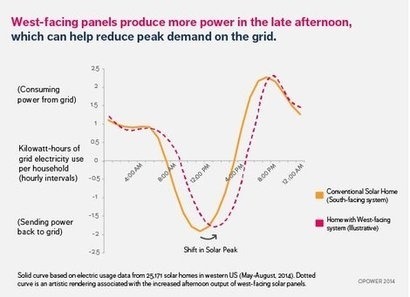
What is the problem?
There’s a stark gap between when solar homes send the most extra power to the grid (~12pm) and when the grid most needs extra power (~5pm). The late-afternoon power system could vastly benefit from importing extra electricity from solar rooftops – as a compelling alternative to utilities firing up additional power plants...But ...most solar rooftops point south...And that means they’ve sent their peak contribution of power to the grid much earlier in the day – when south-facing panels receive their largest dosage of sunlight.
West-facing solar panels are better at producing power in the late afternoon, as the sun sinks and ultimately sets in the western sky. That aligns well with an electric grid that calls for extra power during that time – especially in the hot months.
If the homeowner is paid for excess electricity supplied to the grid (as is the case in the UK) doesn’t solar power additionally serve as an income generator for householders as well as a means of reducing energy bills, therefore where is the problem really? Particularly with energy storage research under way…
See above. By the 4pm hour, most solar homes generate enough power to reduce their own grid electric usage, but not enough to export power back to a grid that desperately needs it.... The number of solar homes spinning their meter backwards drops off rapidly during the late-afternoon hours, just as regional power demand is reaching its pinnacle.
If it is a problem, where does that leave owners of solar panels that face south?
(In the future), a customer’s inclination to install a west-facing system will hinge on incentives. If their utility generously rewards homes that send power back to the grid in the late afternoon, a customer choosing between south-facing and west-facing panels may well opt for the western sky.
Is energy storage an answer?
(In the future), the advent of effective energy storage technology may favour south-facing systems that maximize total electricity production, store it, and then use or export power during hours of peak regional demand....but there's no guarantee that the technology will be available at scale for the residential sector anytime soon.
What is the industry’s reaction to this so far?
The California Energy Commission’s (made a) recent decision to award a subsidy of up to $500 for the installation of west-facing panels on new homes. In the same vein, Arizona’s largest utility recently proposed a $30 monthly lump payment to customers willing to host a west-facing system.
Utilities have already begun to leverage customers – solar and non-solar – as a reliable asset in managing peak electric demand. This past summer, more than 1 million customers across the country participated in ‘Behavioral Demand Response’ programs, wherein small changes in household behavior added up to large-scale regional peak reductions as high as 5%. One can imagine a similar development in the solar arena: a region with 25,000 solar rooftops, especially if strategically oriented, could send as much late-afternoon power back to the grid as a 50 megawatt natural-gas peaker plant.
Is there a move towards time-of-use rates in the US or is this still just an idea?
In the regional dataset we analysed, 4.6% of solar homes are currently enrolled in time-varying rates (compared to 1.3% of non-solar homes).
According to the EIA on December 9th, 2014:
“Time-of-use pricing. California has enacted legislation enabling the CPUC to authorize utilities to default (with the option to opt out) residential customers to a time-of-use rate schedule starting in 2018. Under time-of-use rates, customers' time-varying rates will reflect variation in the cost of generation (unlike traditional rate structures), and may be more likely to shift consumption hours away from periods when peak generation is required from dispatchable units, thereby reducing the amount of resources necessary to meet load.”
Tell me more about the California Energy Commission, what has it been doing about this so far?
In September, the California Energy Commission lit the way when it announced a $500 incentive for the installation of west-facing panels on new homes.
What are the financials of this? How much would it cost to achieve a shift of emphasis towards a western-orientation? How much additional energy could be captured by solar if this was achieved?
Some utilities already offer such time-varying rate plans, in which customers exporting electricity in the late summer afternoon receive significant compensation (e.g. $0.35 per kilowatt-hour) relative to electricity exported around noon (e.g $0.12 per kWh). Offering a handsome incentive for well-timed solar power (or well-timed reductions in usage) can be a smart play for any utility seeking to avoid a painful alternative: paying notoriously high marginal costs to source electricity from “peaker” power plants (e.g. 3-5x the normal price level).
Opower assists utilities around the world to reduce energy consumption and improve their relationship with customers. The company does this through a combination of a cloud-based platform, big data and behavioural science, the aim being to transform the way in which the world’s energy consumers approach household energy conservation. The business has offices in Arlington, Virginia, San Francisco, London, Singapore and Tokyo and employs more than 560 people. It works with more than 95 utility partners, including 28 of the 50 largest US electric utilities, and reaches more than 50 million households and businesses across nine countries.

